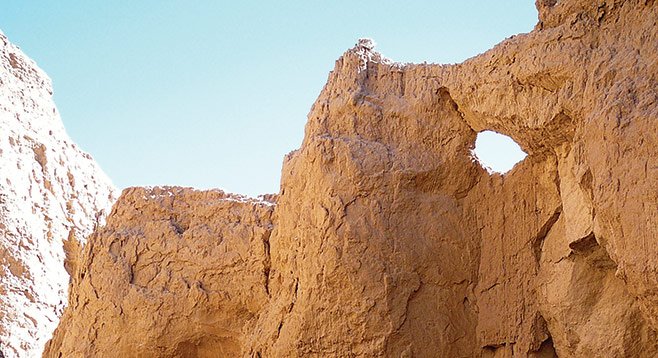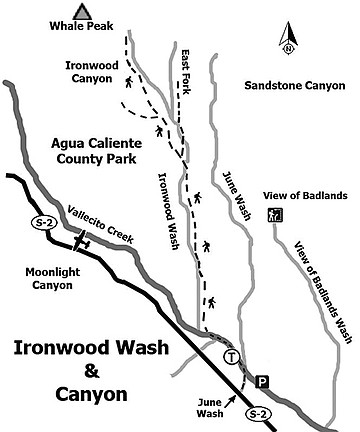 Facebook
Facebook
 X
X
 Instagram
Instagram
 TikTok
TikTok
 Youtube
Youtube


Ironwood Wash and Canyon are not on any map prior to March 11, 2010. That was the date that the U.S. Board on Geographic Names unanimously approved the official naming of this wash and canyon, including its East Fork, as originally proposed by Canebrake community resident Frank Colver in the fall of 2008. Colver noted over 100 ironwood trees in the wash and canyons. There are also multiple palisades and side canyons in its serpentine reach toward Whale Peak. The higher reaches of the canyon have views toward June Wash and the Mud Palisades. The wash flows south to its confluence with Vallecito Creek. Ironwood Wash and Canyon are within the protected state-wilderness area. No vehicles, bicycles, or dogs are allowed in this area and nothing may be removed. Leave only footprints.
Desert ironwood (Olneya tesota) is a member of the pea family. It is considered somewhat of an indicator species of the greater Sonora Desert, although they appear less frequently in our Colorado Desert area west of the Colorado River. Ironwoods are typically found in desert washes below 2000 feet elevation and are the tallest trees in the Sonora Desert, reaching heights of 33 feet. The seeds were gathered, pounded into flour, and eaten by the Kumeyaay. The branches were used in the construction of building materials, and it was valued as firewood for its hot, smokeless fire. The hardwood has been used for carving and for making throwing sticks and musical instruments. Flowers vary in color from cream to lavender and bloom from April to May. They are pollinated by native bees. The flower resembles a sweet pea.

The key to finding the wash and canyon from the parking area is to scan the area looking toward Whale Peak and to look for a line of ironwood trees in the distance that are in a wash. Hike toward the ironwood trees and keep in the same wash. After about three miles, there will be a fork. Stay in the main canyon and do not take the East Fork, which does not have any ironwood trees. From this point, the canyon walls begin to emerge and the force of flashfloods that have carved deeply into the banks becomes evident. Note some of the exposed ironwood roots along the banks.
As one walks deeper and higher into the canyon, the walls constrict and large palisades begin to form. The canyon curves and bends with side canyons becoming evident. At about mile 4 within the main canyon, there is a small opening to a side canyon to the left that can be explored for about half a mile; there, one can find a hole in a sandstone wall.
Beyond this side exploration, the main canyon continues to narrow as it approaches the base of Whale Peak. When it becomes difficult to hike because of tumbled boulders, it is a good place to turn around and head back down the canyon.
In addition to the many ironwood trees, there are mini-forests of teddy-bear cholla. The hillsides have many fine large specimens of barrel cacti. Chuparosa, brittlebush, cheesebush, ocotillo, agave, and catclaw acacia are found in the floor of the canyon.



Ironwood Wash and Canyon are not on any map prior to March 11, 2010. That was the date that the U.S. Board on Geographic Names unanimously approved the official naming of this wash and canyon, including its East Fork, as originally proposed by Canebrake community resident Frank Colver in the fall of 2008. Colver noted over 100 ironwood trees in the wash and canyons. There are also multiple palisades and side canyons in its serpentine reach toward Whale Peak. The higher reaches of the canyon have views toward June Wash and the Mud Palisades. The wash flows south to its confluence with Vallecito Creek. Ironwood Wash and Canyon are within the protected state-wilderness area. No vehicles, bicycles, or dogs are allowed in this area and nothing may be removed. Leave only footprints.
Desert ironwood (Olneya tesota) is a member of the pea family. It is considered somewhat of an indicator species of the greater Sonora Desert, although they appear less frequently in our Colorado Desert area west of the Colorado River. Ironwoods are typically found in desert washes below 2000 feet elevation and are the tallest trees in the Sonora Desert, reaching heights of 33 feet. The seeds were gathered, pounded into flour, and eaten by the Kumeyaay. The branches were used in the construction of building materials, and it was valued as firewood for its hot, smokeless fire. The hardwood has been used for carving and for making throwing sticks and musical instruments. Flowers vary in color from cream to lavender and bloom from April to May. They are pollinated by native bees. The flower resembles a sweet pea.

The key to finding the wash and canyon from the parking area is to scan the area looking toward Whale Peak and to look for a line of ironwood trees in the distance that are in a wash. Hike toward the ironwood trees and keep in the same wash. After about three miles, there will be a fork. Stay in the main canyon and do not take the East Fork, which does not have any ironwood trees. From this point, the canyon walls begin to emerge and the force of flashfloods that have carved deeply into the banks becomes evident. Note some of the exposed ironwood roots along the banks.
As one walks deeper and higher into the canyon, the walls constrict and large palisades begin to form. The canyon curves and bends with side canyons becoming evident. At about mile 4 within the main canyon, there is a small opening to a side canyon to the left that can be explored for about half a mile; there, one can find a hole in a sandstone wall.
Beyond this side exploration, the main canyon continues to narrow as it approaches the base of Whale Peak. When it becomes difficult to hike because of tumbled boulders, it is a good place to turn around and head back down the canyon.
In addition to the many ironwood trees, there are mini-forests of teddy-bear cholla. The hillsides have many fine large specimens of barrel cacti. Chuparosa, brittlebush, cheesebush, ocotillo, agave, and catclaw acacia are found in the floor of the canyon.